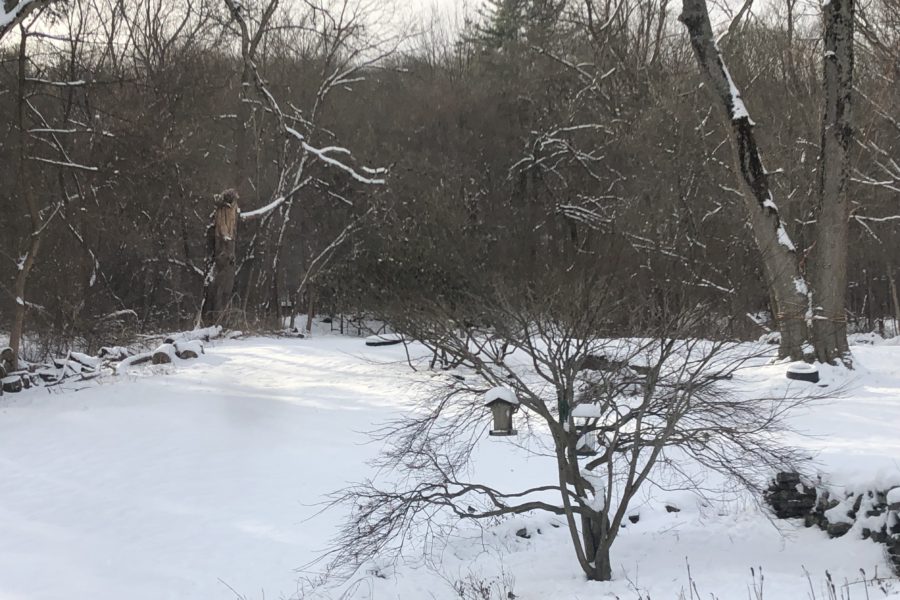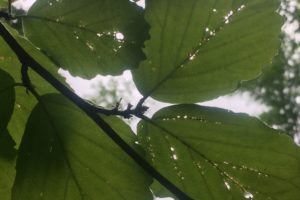Outside the kitchen window are two bird feeders hanging in a weeping Japanese Maple tree. I can watch the story of nature unfold before me. Every week or so I top off the feeders selfishly, in hopes of preserving the cinema of this little tree on a big screen.
When the dark-eyed juncos are there alone only amongst their flock, two at a time hop around on the dimpled snow to pick at the fallen seed mix from the feeder. Three others sit plumply on the small maple twigs. Sometimes a junco will adventurously hop up onto the wooden ledge of feeder, but they prefer to shuffle around on the ground or sit watchful on the limbs.
Black-capped chickadees and titmice fly in and out, tumbling back and fourth relentlessly between the feeder and the blurry edge of the forest. Even from another room I know the titmice are there because I can hear them drumming through the shell of a black sun flower seed on the sill of the kitchen window. Dunt-Dunt-Dunt-Dunt.
A wisp of gray wood smoke spills out of the chimney and rolls over other the feeder. Now a pair of cardinals sit with black masks and chilly feet.
Beyond the feeder the landscape rolls upward and downward in a tangled structure of life. Tall hemlocks are staggered amongst Tulip Poplar, Maple and Ash. Further up the hill there are Walnut, and further still is Black and White Birch. On the highest ridges are Chestnut Oak and Ironwood, where cattle once ran from the low fields to higher pastures. A history of succession of field and forest and man is tilled deeply into the rolling hill flanked in stacked stone and bramble. Somewhere beyond that, in a cavity carved out of an old tree or stump is where the chickadee and the titmice rest. But I wonder by watching them if they ever really rest at all, darting through the winter days. There are old hollow Hackberry snags and sugar maple cavities popping out above the dogwood trees and rhododendron. On some old trees where a limb was is now empty, and full of another life again. Nothing is wasted. Instead, vacancy is traded for the expediency of how the wild things work.
Both the red-bellied and hairy woodpecker visit the feeder too. They are cavity dwellers and rambunctious. Whereas the juncos and chickadees and titmice land with a pastel appearance against the snow, the woodpeckers perch sharply and brilliant, their feather like subway tiles alternating black and white and hot red against the gray winter. Both birds are bossy and seem to explore the entire little maple crown surrounding the feeder when they visit, zooming in and excitedly driving out any others in their way. Urgently hopping and gleaning the valleys between the curved compression wrinkles of the smooth maple bark, up to the feeder and off once again with a strong push, to either sit somewhere else or chisel at a soft, decaying trunk for the larva of things to come.
All day long the birds come out of the forest and return to it. The bold levels of the ecosystem thin and blend together. The pastel and brilliant colors and drab grayness all fold together just like a bird’s wing in flight. The dynamic hierarchy of habitat strings the world together with a long braided rope. Under this fresh blanket of snow everything is stitched together. The small Maple tree with the feeders, the hollow Hackberries, a fallen Black Cherry, the dying ash, the rotten, frozen stumps and field mice; in one thing there is another. The trees in the yard and in the forest live, break and decay away, all the while teeming with the quiet, undeniable, wild essence of life.
The woodpecker churrs in the distance. The titmouse drums in time on the sill. A seed falls from the feeder and a thousand snowflakes shatter. The wafting wings of the juncos and titmice and a singing chicka-dee-dee-dee push winter onward.






Leave a Reply
Your email is safe with us.